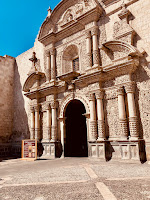The ornate Iglesia de La Compañía de Jesus in Arequipa
The ornate Iglesia de La Compañía de Jesus in Arequipa
 |
| La Compañía |
By coincidence, the city of Arequipa and the Society of Jesus were both founded in the same year - 1540 AD. The original plans of the magnificent Jesuit edifice, Iglesia de La Compañía de Jesus (locals simply call it, La Compañía), were made by one Gaspar Baez - the main structure is in the form of a Latin cross with three deep naves containing side chapels, a transept and a dome on scallops. Unfortunately, the work he began in 1578, collapsed in the earthquake of 1582.
Eight years later, the Jesuit Diego Felipe began the second construction following Gaspar Baez’s plans and construction continued till 1698. It is said that this structure forms the basis of the so-called 'Arequipa school' of architecture which influenced the design and construction of the churches of Cayma, Paucarpata, Yanahuara, Characato and even in the regions of Puno and Bolivia.
The facade and main altar (covered with golden leaves) is built in the Churrigueresque style, a kind of Spanish post-baroque style. Inside the church are 66 canvases from the so-called Cusco School from such illumainaries as Bernardo Bitti and Diego de la Puente.
The former sacristy of the church, now known as Capilla de San Ignacio (St. Ignatius Chapel), after one of the chief founders of the religious order, is a beautiful example of colonial Arequipan art with a stunning copula.
The polychrome cupola is decorated with indigenous murals including flowers, fruits, birds from Amazonia, warriors and cherubs. One stands in awe of the vibrant colours of its walls and the cupola, which have retained their brilliance and intensity over the ensuing centuries, with only minor alterations.
Among all the Claustros de La Compañía (convent cloisters) built in colonial Arequipa, those of La Compañía completed in 1783 stand out not only for its elaborate ornamentation, but also for its grandeur and originality. An army of labourers and slaves comprising Indians and Spanish, worked to shape the popular white sillar limestone rocks, that gives Arequipa its nickname the White City (Ciudad Blanco), brought from the quarries of Chilina and build it without mortar using a technique called ashlar that is best suited to an earthquake prone area like Arequipa.
In the 20th century, the cloisters belonging to the church were sold. In 1972, the church was declared a Historic Monument of Peru. Today, this patio houses boutique handicraft shops, and on the first floor you get a breathtaking view of the snow capped peaks overlooking the city. In the middle of the patio, there is a fountain and arcades carved with floral designs.
Historical note: The religious order 'La Compañía de Jesús' has existed in Peru since 1568 under the direction of San Francisco de Borja. The first Jesuit construction in all of Latin America. Their evangelizing work took them to the most remote places of the Spanish colony, from the famous missions of Maynas to the big cities such as Lima, Cusco and Arequipa. They are expelled from Peru in 1767 by order of King Carlos III, returning finally in 1871 where they remain to date.
Address: Corner of Moran and Alvarez Tornas, Cercado District, Province and Region of Arequipa. The Cloisters are located in Calle Moral 118
How to get there: Iglesia de la Compañía de Jesús is centrally located to the South-east corner of Plaza de Armas - a mere 2 minute walk.
Timings: The church is open seven days a week, daily between 8 am morning and 8 pm evening. Mass is celebrated Monday through Saturday at 12pm, 6pm, and 7pm and Sunday at 10am, 12pm, 6pm, and 7pm, so if you don’t plan to participate, visit outside of those times.
Cost: The entrance to the church is free to enter. However entrance to the Capilla de San Ignacio (St. Ignatius Chapel) costs S/20 Peruvian per person.









Comments
Post a Comment
Please keep conversations courteous and on-topic. Kindly don’t engage in trolling, flame-baiting, name-calling, insulting, stereotyping or gratuitous attacks. Thank you for being a good citizen.